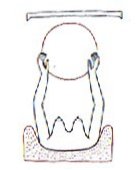|
TRANSLATIONS
Next page:
Is vae kore always connected with ua, and therefore (implicitly) with the onset of the 2nd half of the year? The examples used (excepting the special Aa1-1) seem to say so. And already on the second page of vae kore I have suggested a gradual development:
The last two could refer to the end of the 3rd and 4th quarters (or rather the end of the 1st and 2nd halves of the 2nd half of the year). The special Aa1-1 could be the opposite of the normal vae kore - it could mean the beginning of the 1st half of the year. The curious 'knee joint' could once have been used to say '2' (referring to the 2nd half of the year). The creator of Keiti could have missed the idea when inserting twin glyphs:
The 'knee joint' ought to express some idea, and being at left it could refer to the cardinal point just passed. If so, then the idea of '2' would come automatically. When 3 fingers are 'hidden' inside the fist but the thumb is outside, it could mean the season of 3 has closed and will wait until next cycle to be opened again. The last and summary page:
At first I had written: '... indeed there are no legs used in lifting up a new light from the horizon in the east.' But then I realized the possibility of moon being the new light. |

















